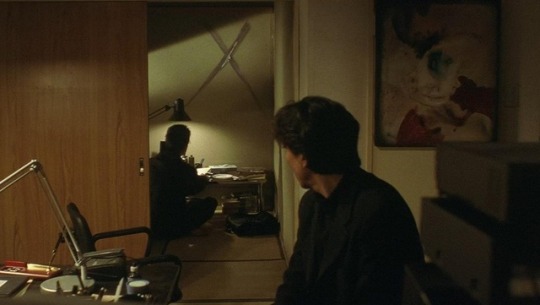 |
| Via Tumblr |
Greetings, everyone! As other pop culture websites have decided to talk about traditional horror movies once a day until Halloween, at Pop Culture we couldn't resist to do a similar feature, albeit with less days to cover, and that's how 21 Days of Spooky was born.
21 Days of Spooky is not about pop culture that sets out to fright you with brain-eating, viscerae-hanging, slash-killing scenes, but with thoughts that linger and persist on your life long after you've watched them. Or are just downright creepy. Tonight's spooky: Kiyoshi Kurosawa's Cure. Some spoilers ahead.
What's it about?: Cure is about a detective that's investigating a series of grisly murders in which the victims all have an X carved into their necks. The catch? There's a different killer each time. So our detective must find out what do these murderers have in common before things go even more south.
This film is pretty much hard to explain, but it is one of my favorites (and Bong Joon-ho's as well, apparently), so I'll do my best to get you into the vibe and explain the spookiness without fully ruining the plot.
Let's put it this way: have you ever felt confused and powerless over a situation, overwhelmed by something that's beyond your grasp, but you know deep inside that you can sort it out, make it work? Well, that's the mindset of our main character, Kenichi (Kōji Yakusho). He's been on the force for a long time, has a mentally unstable wife and, to boot, has to deal with a case that's straight-up weird. None of the murderers seem to have anything in common, they all turn themselves in and confess, but can't explain why they have committed said murders.
Thankfully, the film gives us an explanation somewhat quick. All the murderers have been in the vicinity of Mamiya (Masato Hagiwara), who appears to be a master of hypnosis, and quite a spooky man himself. Of course, this solves nothing, as Mamiya seems to have the memory of Finding Nemo's Dory, yet replies to Kenichi with extremely personal questions as he's interrogated. Add a very unaccesible puppeteer figure to all the mumbo-jumbo Kenichi's been going through, and you can bet he starts losing his mind. And we're only 1/3rd into the film, at best.
From there on, Cure spirals into this cat-and-mouse chase involving Kenichi and, well, also Kenichi. The murders fortunately stop, but then our friendly detective's psychologist friend discovers some gruesome stuff, there's plenty of suicides, weird carvings on walls, and all of this while Mamiya's chilling out at a cell, cut from all contact (with the exception of Kenichi himself).
Is Kenichi's own stubborness the reason for his downfall? Any other cop would be like "yeah, okay, so this dude incited everyone to kill, case closed, let's get some pizza", but he's not your average cop, so he has to continue investigating the subject of mesmerism, talking to Mamiya (who, should I add, is delighted that he can't incite Kenichi to kill people), and continue feeding those nightmares that have been plaguing him forever. Why? Because he needs to know. How could one man kill all those people without involving himself? Has this happened before? Will it continue happening if he doesn't somehow stop it?
And it's a completely fine explanation. Mamiya used to study hypnosis, so anyone else can. We see that archival footage shows these murders have been happening since the 1800s, through dudes gesturing Xs mid-air to people. Humanity is screwed, but not if Kenichi can stop it, but how?
By the time the final act strikes, with our suggestive killer escaping prison, you think you know what's gonna happen. Well, think again. That's what's truly frightening about this film, that you're just as in the dark and confused as our main character. Nothing I've summarized/explained here can even start propping you up in the right direction. It's not a weird film, it's not hard to understand, it just drains you of all hope to the point that you're begging for an answer you know you're not gonna get.
Depending on the viewer, you do get an answer. Just probably not the answer you expected. And said answer possibly sets out an even bleaker viewpoint. But that's what you get for wanting justice, peace, and understanding. It's what makes it a great scary pop culture piece to start this feature.
Tomorrow: Eel's a waterful life with Gore Verbinski's A Cure for Wellness.
No comments:
Post a Comment